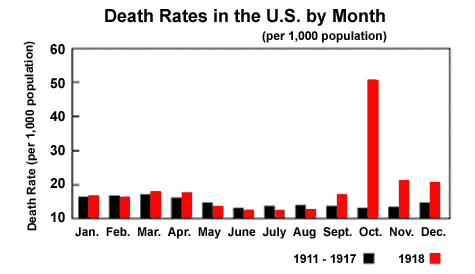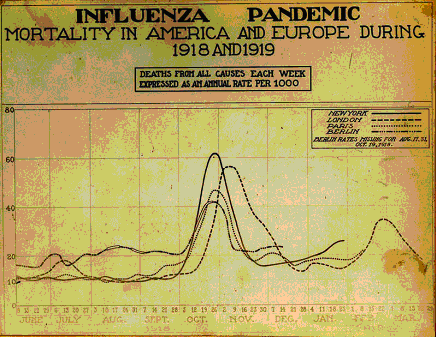Lesson 2
Essential Question
- To what extent can a pandemic disease affect a society?
Background
The 1918 influenza pandemic killed more than 20 million people worldwide. It affected 25% of the U.S. population and crippled society. In one year, the average American life expectancy dropped by 12 years. The graph below shows the particularly brutal months of late 1918 in the United States. At that time, influenza had killed more than any disease in recorded history.

The primary source graph below shows the large increase in deaths in four major world cities over a two-month period in late 1918.

Source: National Museum of Health and Medicine
Instructional Strategies
Strategy 1
Gathering Information: Constructivist Approaches
Post the essential question for students. Conduct a Think/Pair/Share activity in which students brainstorm possible responses individually, then in pairs, and then share ideas with the class.
Have students research the 1918 influenza pandemic in the U.S. and complete a chart like the one below to categorize their notes.
Primary Sources |
Secondary Sources |
|
| Perceived causes of the pandemic | ||
| Actual causes of the pandemic | ||
| Effects of the pandemic |
||
| Medical response to the pandemic | ||
| Government response to the pandemic |
Possible online sources (including an MP3 video):
- The Deadly Virus: The Influenza Epidemic of 1918
- Talking History’s Fred Nielsen and author John M. Barry discuss the flu epidemic of 1918. According to our guest, it was the world’s most lethal epidemic- responsible for the deaths of more people in 24 weeks than the Black Death killed in a hundred years. John Barry is author of The Great Influenza: The Epic Story of the Deadliest Plague in History. Airdate: November 14, 2005.
- Delaware was hit hard by 1918 pandemic
Check for Understanding = Formative Assessment
Have students make generalizations that compare the 1918 influenza pandemic in the U.S. to the European pandemic in the 14th century. Examples might include:
- More people died in the 1918 influenza pandemic even though the medical technology was more advanced.
- More people died in the 1918 influenza pandemic than the European pandemic in the 14th century because there were more people.
- The 1918 pandemic was caused by a virus instead of bacteria.
- The ways that people coped with the pandemic in different times depended on their degree of medical knowledge.
Strategy 2
Extending and Refining: Concept Development
Have students Think/Pair/Share to add, delete, or substitute the information in their charts from strategy 1 using the following information.
- Examine the historical sources at these two internet sites.
- Create a slide show in which you categorize or group together photographs from the first two internet sites. Identify labels or names for your groupings.
- Why should they be grouped together? Defend your responses.
Check for Understanding = Formative Assessment
Interpret these published documents from different levels of American government.
- U.S. Public Health Service Influenza Advice
- Washington, D.C. Health Department Influenza Care and Prevention
More people died in the 1918 influenza pandemic even though the medical technology was more advanced.
- What do these primary sources reveal about the role of government at different levels during the pandemic?
- What do these primary sources reveal about the medical knowledge of the early 20thcentury? Would the advice on how to care for and avoid influenza have worked?
Strategy 3
Application: Using Complex Sources
Model how to use a more complex source of information by following these steps:
- Relate it to prior knowledge – review what students already know about the impact of the 1918 influenza.
- Help students break the reading into parts.
- Develop a working knowledge of the vocabulary by starting a Word Wall of vocabulary words important to this unit and add to the word wall as students move through the module. These terms that come out of the discussion should be used by students as they continue their learning. Some examples as instruction progresses through the activities are:
Word Definition pandemic influenza plague vaccine gross net criteria or criterion - Have students work cooperatively to read one of the following documents and apply this process.
- a 1999 article from the Center for Disease Control, The Economic Impact of Pandemic Influenza in the United States
- a 2003 article from the New York Times, What is the Next Plague?
- Circulation of Money May Predict Pandemics
Check for Understanding = Formative Assessment
- Use the vocabulary of the document you read and the Word Wall as you respond to these questions.
- What policy decisions should a government make to limit the negative effects of a pandemic?
- What priorities should set criteria for those decisions?
- What should be the role of the government if a pandemic strikes?
- This 1918 photograph shows a conductor in Seattle, WA, refusing to allow passengers without masks to board the public train.




